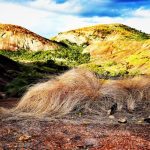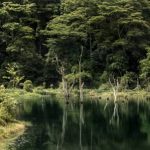TREE LIFE
June 2010
MASHONALAND CALENDAR
Sunday, 20th June: Visit to Chedgelow Farm By kind permission of John Danckwerts and Mary Lovemore, the main outing for June will be to Chedgelow Farm, south of Harare.
Please bring a chair, water and a hat and a packed lunch. We will meet at the picnic site at 9:30 a.m.
Sunday, 27th June: Show and Tell
Following from the success of the two ‘Show and Tell’s last year, we have arranged another one for Sunday 27th June. The event will begin at 2.30 p.m. at Mark Hyde’s home.
All members are welcome. The object of this event is for members to show other members items of interest. These may be photographs, slides, specimens, books or anything else related to Zimbabwean plants or trees.
Presentations may be as short as you like; longer ones will be strictly limited to 20 – 30 minutes depending on how many people wish to present. I have an LCD projector for displaying electronic images, but if anyone wishes to display slides, they will need to organize a projector.
The presentation part of the event will last until about 5 p.m. when we will have a ‘bring and share’ supper. The Society will contribute some wine.
Remember that the success of this event depends on you so come prepared to share some interesting information with us!
Please bring:
* items to show and discuss (if you have any – you may of course simply look at what others bring)
* food and drink for the supper.
Zimbabwe Species Listed in the Global Invasive Species Database
There are 33 invasive species listed for Zimbabwe in the Global Invasive Species Database, and included are aquatic plants, grasses, fish, insects, birds, and micro-organisms that cause disease—but there are only 7 trees/shrubs identified as invasive. These, with the listing of common names abbreviated, are:
1. Acacia mearnsii
Black wattle, Acacia mearnsii is a fast- growing leguminous tree. Native to Australia, A. mearnsii is often used as a commercial source of tannin or a source of firewood for local communities. It threatens native habitats by competing with indigenous vegetation, replacing grass communities, reducing native biodiversity and increasing water loss from riparian zones.
Common Names: acácia-negra, Australian acacia, Australische akazie, black wattle, swartwattel, uwatela
Synonyms: A. decurrens var. mollis, Acacia mollissima
2. Dalbergia sissoo

Dalbergia sissoo. Photo Mark Hyde. Source : Flora of Zimbabwe
Dalbergia sissoo is a perennial tree that is economically important for its value in forestry, agroforestry, and horticulture. It provides timber, fuelwood, fodder, has medicinal value, is used extensively as an ornamental tree as well as for shading, erosion control, and soil fertility. Native to the Indian sub-continent, it is a member of the legume family and can fix nitrogen from the atmosphere through bacteria nodules on its root system. It has been introduced in various countries throughout the world, but has known to be invasive in Australia and in Florida (U.S.).
Common Names: Bombay blackwood, dalbergia, ébénier juane, Himalaya raintree, India teakwood, Indian rosewood, ostindisches Rosenholz
Synonyms: Amerimnon sissoo (Kuntze), Dalbergia pseudo-sissoo (Miq.)
3. Leucaena leucocephala
Leucaena leucocephala is a ‘conflict tree’, being widely promoted for tropical forage production and reforestation while at the same time it is spreading naturally and is widely reported as a weed. This seedy thornless tree can form dense monospecific thickets and is difficult to eradicate once established, rendering extensive areas unusable and inaccessible, and threatening native plants in some areas.
Common Names: acacia palida, aroma blanca, cassis, faux mimosa, faux-acacia, graines de lin, horse/wild tamarind, jumbie bean, lead tree, tamarindo silvestre, wild mimosa, wild tamarind, zarcilla
Synonyms: Acacia leucocephala (Lamark) Link 1822, Leucaena glabrata Rose 1897, Leucaena glauca (L.) Benth. 1842, Mimosa leucocephala Lamark 1783
4. Prosopis spp.
Plant members of the genus Prosopis, which are commonly known as mesquite or algarrobo, include at least 44 defined species and many hybrids. Native to the Americas, they are fast growing, nitrogen- fixing, very salt and drought tolerant shrubs or trees. Most are thorny, although thorn-less types are known. Animals eat the pods and may spread seeds widely. Trees develop a shrubby growth form if cut or grazed.
Common Names: acacia de Catarina, algarroba, algarrobo del Brasil, aroma, baron, bayahonde française, cashaw, cashew, espino negro, mesquite, Mexican thorn, screwbeans, yaque blanco, yaque negro
5. Psidium guajava
Psidium guajava is a tropical tree or shrub. It is native to tropical central America from Mexico to northern South America. It has been introduced to most tropical and sub-tropical locations around the world for its edible fruit. In some countries the harvesting, processing and export of the fruit forms the basis of a sizeable industry. Due in part to its ability to grow on a variety of soils and across a range of climates, P. guajava has become invasive. Pastures and fields are overrun and native plants are outcompeted by this species, which has the ability to form dense thickets. This has led to its designation in many areas as a noxious weed to be controlled or eradicated. It is ranked by some authorities among the highest invasive categories.
Common Names: guava, ngguava ni India, oi, quwawa, tuava, tuvava, xalxocot
Synonyms: Guajava pyrifera (L.) Kuntze, Myrtus guajava var. pyrifera (L.) Kuntze, Myrtus guajava (L.) Kuntze, Psidium aromaticum, Psidium cujavillus Burm. f., Psidium guajava var. cujavillum (Burman) Krug and Urb., Psidium guajava var. guajava, Psidium guava Griseb., Psidium guayava Raddi, Psidium igatemyensis Barb. Rodr., Psidium pomiferum L., Psidium pumilum var. guadalupense, Psidium pumilum Vahl, Psidium pyriferum L.
6. Ziziphus mauritiana

Ziziphus mauritiana. Photo Bart Wursten. Source: Flora of Zimbabwe
Ziziphus mauritiana, more commonly known as the Chinese apple, is widely cultivated in dry areas throughout the tropics. The Chinese apple has a multitude of uses from culinary to medicinal values and also has the ability to tolerate extremely dry habitats. This makes it an extremely valuable tree for many different cultures that live in such climates. It also has the ability however to form dense stands and become invasive in some areas, including Fiji and Australia. In Australia, Ziziphus mauritiana has a capacity to greatly expand its current range in northern and northeastern Australia. The main industry affected is the cattle industry but the species also has environmental impacts in woodland and savanna ecosystems.
Common Names: Chinese apple, Chinese date, crabapple, dunks, Indian cherry, Indian jujube , Indian plum, manzana (apple), manzanita (little apple), petit pomme, putrea,
Synonyms: Rhamnus jujuba L., Rhamnus mauritiana Soyer-Willemet, Ziziphus jujuba (L.) Lam., non P. Mill., Ziziphus aucheri Boiss., Ziziphus jujuba (L.) Gaertn., Ziziphus jujuba (L.) Gaertn. var. fruticosa Haines, Ziziphus jujuba (L.) Gaertn. var. stenocarpa Kuntze, Ziziphus mauritiana Lam. var. deserticola A. Chev., Ziziphus mauritiana Lam. var. orthacantha (DC.) A. Chev., Ziziphus orthacantha DC, Ziziphus poiretii G. Don, Ziziphus rotundata DC.
7. Lantana camara
Lantana camara is a significant weed of which there are some 650 varieties in over 60 countries or island groups. It is established and expanding in range in many regions of the world and impacts severely on agriculture and farming as well as replacing native forests when land is cleared for agriculture. It has been the focus of biological control attempts for a century, yet still poses major problems in many regions.
Common Names: ach man, angel lips, big sage, blacksage, flowered sage, lantana, prickly lantana, shrub verbean, supirrosa, Wandelroeschen, white sage, wild sageSynonyms: Camara vulgaris, Lantana scabrida
Tree Lore—The Hazel
Unlike last month’s featured tree—the Elder, the Hazel has generally a much more positive set of associations. For example:
• Hazel can be used to decorate the hair with individual twigs or by making a ‘Wishing Cap’. This is custom followed in many countries. If a person made a wish while wearing a wishing cap, the wish would be fulfilled.
• The seeds of the hazel tree, Hazel nuts, were also believed to possess mystical powers and could be used in divining. The nut is believed to be at its strongest on Halloween night, which was also called ‘Nutcrack Night’ in England. Lovers were recommended to use these powers to gain foresight into romantic relationships.
‘Two hazel nuts I threw into the flame,
And to each nut I gave a sweetheart’s name.
This, with the loudest bounce me sore amazed,
That, with a flame of brightest colour blazed.
As blazed the nut, so may thy passion grow,
For ’twas thy nut that did so brightly glow.’
Gray
Famous Trees of Africa L’Arbre du Ténéré
The Ténéré is a desert region in the south central Sahara with an extremely hot and dry climate and virtually no plant life. Yet, until 1973, there was a very well known, lonely acacia tree called the Tree of Ténéré (L’Arbre du Ténéré) that become a landmark on caravan routes and was even shown on a map. For decades, the tree had stood alone in the vast arid desert near a 40-meter-deep well, until a drunk driver allegedly knocked it down. In remembrance to what was once considered to be the most isolated tree on earth, a metal pole has been put in its place today.



